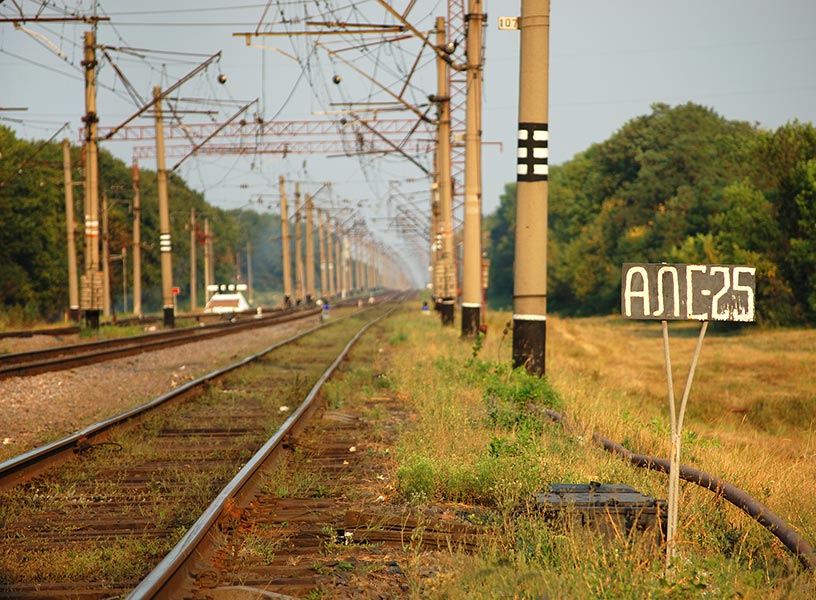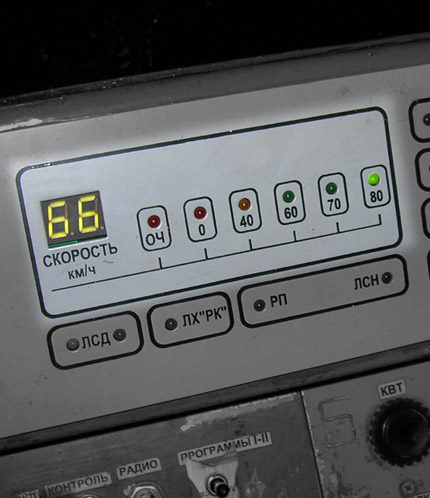ALSN on:
[Wikipedia]
[Google]
[Amazon]
ALSN (Автоматическая локомотивная сигнализация непрерывная, in Latin - Avtomaticheskaya Lokomotivnaya Signalizatsiya Nepreryvnaya, meaning ''Continuous Automatic Train Signalling'') is a train control system used widely on the main lines of the ex-Soviet states (Russian Federation, Ukraine, Belarus, Latvia, Lithuania, Estonia). It uses modulated pulses inducted into rails similar to the Italian RS4 Codici and American Pulse Code Cab Signaling. On high-speed lines the variant ALS-EN (АЛС-ЕН) is used which takes advantage of a double phase difference modulation of the  The name ALSN (АЛСН - автоматическая локомотивная сигнализация непрерывного действия) is composed of ALS, literally "Automatic Locomotive Signalling" (АЛС - автоматическая локомотивная сигнализация) and the variant designation N "Continuous Effect" (Н - Непрерывного действия). Other variants are built according to the same scheme like ALST (АЛСТ) for "Fixed Point Automatic Train Signalling" (АЛС точечного действия) and ALSR (АЛСР) for "Radio-Based Automatic Train Signalling" (АЛС с использованием радиоканала). The term ALS-ARS (АЛС-АРС) refers to "Automatic Train Signalling with Automatic Speed Regulation" (автоматическая локомотивная сигнализация с автоматическим регулированием скорости) used in
The name ALSN (АЛСН - автоматическая локомотивная сигнализация непрерывного действия) is composed of ALS, literally "Automatic Locomotive Signalling" (АЛС - автоматическая локомотивная сигнализация) and the variant designation N "Continuous Effect" (Н - Непрерывного действия). Other variants are built according to the same scheme like ALST (АЛСТ) for "Fixed Point Automatic Train Signalling" (АЛС точечного действия) and ALSR (АЛСР) for "Radio-Based Automatic Train Signalling" (АЛС с использованием радиоканала). The term ALS-ARS (АЛС-АРС) refers to "Automatic Train Signalling with Automatic Speed Regulation" (автоматическая локомотивная сигнализация с автоматическим регулированием скорости) used in
 The system makes use of several distinct
The system makes use of several distinct
 A similar in general theory of operation, but differently implemented, is an ALS-ARS system used in subways of the former Soviet Union. It uses low frequency signals transmitted and received as described above, with the difference that the signals are
A similar in general theory of operation, but differently implemented, is an ALS-ARS system used in subways of the former Soviet Union. It uses low frequency signals transmitted and received as described above, with the difference that the signals are
File:ALS-zhel.jpg, ALSN railway cab signal
File:Valve-EPK-150E.jpg, Electro-pneumatic valve which causes emergency brakes to be applied should the driver fail to acknowledge vigilance check or exceed a speed limit
File:Inductor-KLUB.jpg, ALSN pickup coil
{{DEFAULTSORT:Als-N
Train protection systems
Railway signalling in Russia
carrier wave
In telecommunications, a carrier wave, carrier signal, or just carrier, is a waveform (usually sinusoidal) that is modulated (modified) with an information-bearing signal for the purpose of conveying information. This carrier wave usually has ...
.
 The name ALSN (АЛСН - автоматическая локомотивная сигнализация непрерывного действия) is composed of ALS, literally "Automatic Locomotive Signalling" (АЛС - автоматическая локомотивная сигнализация) and the variant designation N "Continuous Effect" (Н - Непрерывного действия). Other variants are built according to the same scheme like ALST (АЛСТ) for "Fixed Point Automatic Train Signalling" (АЛС точечного действия) and ALSR (АЛСР) for "Radio-Based Automatic Train Signalling" (АЛС с использованием радиоканала). The term ALS-ARS (АЛС-АРС) refers to "Automatic Train Signalling with Automatic Speed Regulation" (автоматическая локомотивная сигнализация с автоматическим регулированием скорости) used in
The name ALSN (АЛСН - автоматическая локомотивная сигнализация непрерывного действия) is composed of ALS, literally "Automatic Locomotive Signalling" (АЛС - автоматическая локомотивная сигнализация) and the variant designation N "Continuous Effect" (Н - Непрерывного действия). Other variants are built according to the same scheme like ALST (АЛСТ) for "Fixed Point Automatic Train Signalling" (АЛС точечного действия) and ALSR (АЛСР) for "Radio-Based Automatic Train Signalling" (АЛС с использованием радиоканала). The term ALS-ARS (АЛС-АРС) refers to "Automatic Train Signalling with Automatic Speed Regulation" (автоматическая локомотивная сигнализация с автоматическим регулированием скорости) used in subway
Subway, Subways, The Subway, or The Subways may refer to:
Transportation
* Subway, a term for underground rapid transit rail systems
* Subway (underpass), a type of walkway that passes underneath an obstacle
* Subway (George Bush Intercontin ...
s which is a form of an automatic train control
Automatic train control (ATC) is a general class of train protection systems for railways that involves a speed control mechanism in response to external inputs. For example, a system could effect an emergency brake application if the driver d ...
system.
ALSN operation principles
 The system makes use of several distinct
The system makes use of several distinct pulse train
A pulse wave or pulse train is a type of non-sinusoidal waveform that includes square waves (duty cycle of 50%) and similarly periodic but asymmetrical waves (duty cycles other than 50%). It is a term used in synthesizer programming, and is ...
patterns of alternating current flowing through a track circuit to convey an aspect of the next signal. The circuit comprises the feedpoint at the next signal, one running rail, first locomotive axle, another running rail and back to the signal feedpoint. The resulting electromagnetic field is picked up by receiver coils located just front of the first axle of the locomotive. The signal is then amplified, filtered and evaluated.
If the received signal changes from a more permissive to a less permissive aspect (like when passing a yellow light, indicating the next signal is red, which, in turn, requires stopping in front of it), an immediate vigilance control
A dead man's switch (see alternative names) is a switch that is designed to be activated or deactivated if the human operator becomes incapacitated, such as through death, loss of consciousness, or being bodily removed from control. Originally a ...
acknowledge is required; depending on configuration and aspects, periodic checks and a speed limit may be enforced as well.
The benefits of the system are relative encoder simplicity (a simple motor-operated cam
Calmodulin (CaM) (an abbreviation for calcium-modulated protein) is a multifunctional intermediate calcium-binding messenger protein expressed in all eukaryotic cells. It is an intracellular target of the secondary messenger Ca2+, and the bin ...
wheel closing and opening relay contacts generates the pulse train) and the ability to use the same signal for track occupancy detection. The drawbacks are a somewhat long response time unsuitable for high speed operation (which resulted in ALS-EN's implementation), and the necessity to switch between 25/50/75 Hz frequency variants depending on traction current type (AC/DC) and other conditions.
VEPS
A new, modular ALSNautomatic train protection
Automatic train protection (ATP) is a type of train protection system which continually checks that the speed of a train is compatible with the permitted speed allowed by signalling, including automatic stop at certain signal aspects. If it i ...
onboard system VEPS has been under development since 2002 in Estonia
Estonia, formally the Republic of Estonia, is a country by the Baltic Sea in Northern Europe. It is bordered to the north by the Gulf of Finland across from Finland, to the west by the sea across from Sweden, to the south by Latvia, an ...
. Based on programmable logic controller
A programmable logic controller (PLC) or programmable controller is an industrial computer that has been ruggedized and adapted for the control of manufacturing processes, such as assembly lines, machines, robotic devices, or any activity t ...
technologies, the system was developed by Estonian Railway engineers and patented in 2004 by Indrek Syld. The new system was installed in the CE35 type of locomotive (77 systems) during 2003-2004. A new platform (level 2.0) was installed on Stadler's FLIRT
Flirting or coquetry is a social and sexual behavior involving spoken or written communication, as well as body language. It is either to suggest interest in a deeper relationship with the other person or, if done playfully, for amusement.
I ...
trains for Estonia in 2012 (76 systems), and in 2016 a third generation of the system was introduced for the international market.
KLUB
Since the 1990s, the Russian Railroad Company has introduced a computerized successor system KLUB-U which requires either ALSN only or both, ALSN and ALS-EN sensors for compatibility. InERTMS
The European Rail Traffic Management System (ERTMS) is the system of standards for management and interoperation of signalling for railways by the European Union (EU). It is conducted by the European Union Agency for Railways (ERA) and is the o ...
the ALSN/ALS-EN systems are listed as ETCS
The European Train Control System (ETCS) is the signalling and control component of the European Rail Traffic Management System (ERTMS). It is a replacement for legacy train protection systems and designed to replace the many incompatible s ...
Class-B systems.
ALS-ARS
 A similar in general theory of operation, but differently implemented, is an ALS-ARS system used in subways of the former Soviet Union. It uses low frequency signals transmitted and received as described above, with the difference that the signals are
A similar in general theory of operation, but differently implemented, is an ALS-ARS system used in subways of the former Soviet Union. It uses low frequency signals transmitted and received as described above, with the difference that the signals are continuous wave
A continuous wave or continuous waveform (CW) is an electromagnetic wave of constant amplitude and frequency, typically a sine wave, that for mathematical analysis is considered to be of infinite duration. It may refer to e.g. a laser or partic ...
and the signal's ''frequency'' determines its code meaning, which results in much faster response time. Typically, two frequencies are transmitted at the same time, indicating the current speed limit and, if lower, the limit for the next section, providing the train driver with a warning and time to react and reduce speed.
In case of an overspeed, the train is unconditionally braked to the indicated speed limit, and then, if not acknowledged by a driver pressing a vigilance button, to a complete stop. Should be there no frequency received (such as on an uncoded track in a maintenance depot or in case of an equipment failure), the driver may proceed at a low speed while holding a vigilance pedal.